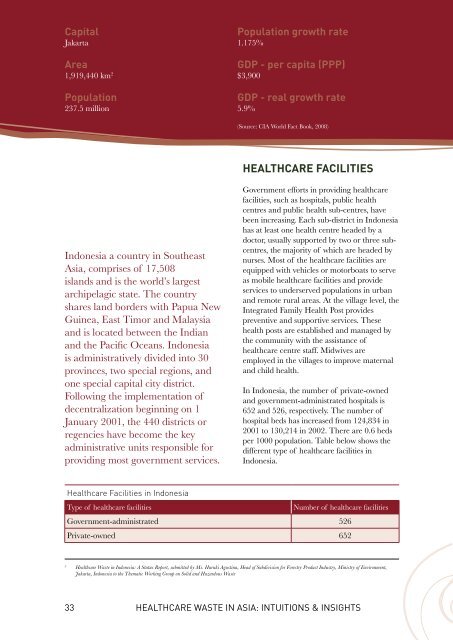Healthcare Waste Report - Environment Health
Healthcare Waste Report - Environment Health
Healthcare Waste Report - Environment Health
Create successful ePaper yourself
Turn your PDF publications into a flip-book with our unique Google optimized e-Paper software.
Capital<br />
Jakarta<br />
Area<br />
1,919,440 km 2<br />
Population<br />
237.5 million<br />
Indonesia a country in Southeast<br />
Asia, comprises of 17,508<br />
islands and is the world’s largest<br />
archipelagic state. The country<br />
shares land borders with Papua New<br />
Guinea, East Timor and Malaysia<br />
and is located between the Indian<br />
and the Pacific Oceans. Indonesia<br />
is administratively divided into 30<br />
provinces, two special regions, and<br />
one special capital city district.<br />
Following the implementation of<br />
decentralization beginning on 1<br />
January 2001, the 440 districts or<br />
regencies have become the key<br />
administrative units responsible for<br />
providing most government services.<br />
<strong><strong>Health</strong>care</strong> Facilities in Indonesia<br />
Population growth rate<br />
1.175%<br />
GDP - per capita (PPP)<br />
$3,900<br />
GDP - real growth rate<br />
5.9%<br />
(Source: CIA World Fact Book, 2008)<br />
HEALTHCARE FACILITIES<br />
Government efforts in providing healthcare<br />
facilities, such as hospitals, public health<br />
centres and public health sub-centres, have<br />
been increasing. Each sub-district in Indonesia<br />
has at least one health centre headed by a<br />
doctor, usually supported by two or three subcentres,<br />
the majority of which are headed by<br />
nurses. Most of the healthcare facilities are<br />
equipped with vehicles or motorboats to serve<br />
as mobile healthcare facilities and provide<br />
services to underserved populations in urban<br />
and remote rural areas. At the village level, the<br />
Integrated Family <strong>Health</strong> Post provides<br />
preventive and supportive services. These<br />
health posts are established and managed by<br />
the community with the assistance of<br />
healthcare centre staff. Midwives are<br />
employed in the villages to improve maternal<br />
and child health.<br />
In Indonesia, the number of private-owned<br />
and government-administrated hospitals is<br />
652 and 526, respectively. The number of<br />
hospital beds has increased from 124,834 in<br />
2001 to 130,214 in 2002. There are 0.6 beds<br />
per 1000 population. Table below shows the<br />
different type of healthcare facilities in<br />
Indonesia.<br />
Type of healthcare facilities Number of healthcare facilities<br />
Government-administrated 526<br />
Private-owned 652<br />
3 <strong><strong>Health</strong>care</strong> <strong>Waste</strong> in Indonesia: A Status <strong>Report</strong>, submitted by Ms. Haruki Agustina, Head of Subdivision for Forestry Product Industry, Ministry of <strong>Environment</strong>,<br />
Jakarta, Indonesia to the Thematic Working Group on Solid and Hazardous <strong>Waste</strong><br />
33 HEALTHCARE WASTE IN ASIA: INTUITIONS & INSIGHTS

















